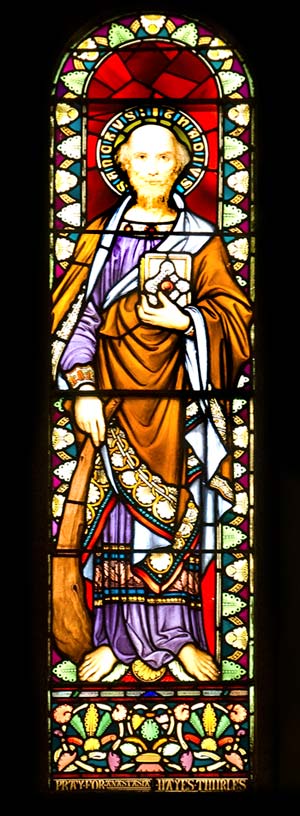
Remember Ireland’s National Heritage Week 2019 begins August 17th – August 25th.
To the less well informed, he appears to be carrying a Hurley stick, and this comes as no surprise since his icon is to be found in Thurles, Co. Tipperary, latter the undisputed home of hurling.
He is regularly a point of focus; visited on numerous occasions daily here in the Cathedral of the Assumption Thurles, since he is also the Patron Saint of hope for ‘hopeless cases and lost causes.’
Indeed, for this latter reason we understand many hurling supporters from Co. Laois have made a pilgrimage here to Thurles Cathedral this week, hoping for a better outcome, but in the knowledge that they will be forced to do battle with the mighty Tipperary hurling selection next Sunday. 🤣 🤣 🤣
All jesting aside, the Saint to whom I refer of course is St. Jude (Judas Thaddaeus), one of the Twelve Apostles of Jesus. A farmer by trade; St. Jude according to legend, was the son of Clopas and Mary of Clopas, herself a sister of the Virgin Mary, latter the mother of Jesus.
St. Judas Thaddaeus became known as simply St. Jude after early translators of the New Testament sought to disassociate his similar name totally from that of another apostle named as Judas Iscariot; subsequently abbreviating his forename. The Bible informs us that Judas Iscariot betrayed Jesus Christ to “a great multitude with swords and staves, from the chief priests and elders of the people”, in the Garden of Gethsemane, in Jerusalem.
The icon of St. Jude (Judas Thaddaeus) can be located over to the right-hand-side, as the visitor faces the Tabernacle in Thurles Cathedral; displayed in one of the many beautiful stained-glass windows, designed and manufactured by Franz Mayer & Co of Munich, Germany. And no, he is not carrying a Hurley stick in his right hand, rather he holds a Hurley shaped club, the symbol or attribute of what was to be his eventual martyrdom.
The window asks for prayers for Anastasia Hayes, Thurles.
After Jesus Christ’s death and following his precise command, (“Go ye into all the world, and preach the gospel to every creature”), Saint Jude began preaching the Gospel in Judea, Samaria (Palestine), Idumaea (Jordan), Syria, Mesopotamia (Iraq, Kuwait) and Libya.
He was to suffer martyrdom about 65 AD in Beirut, Syria, together with the apostle Simon the Zealot, (the Zealot – to distinguish him from Simon Peter).
Sometime after his death, his body was brought from Beirut to Rome and placed in a crypt in St. Peter’s Basilica. Today, his bones are in the left transept of St. Peter’s Basilica under the main altar of St. Joseph in one tomb with the remains of the apostle Simon the Zealot.
It should be noted that almost all Christian Saints were traditionally represented in visible format by a symbol or attribute, usually carried in their hand. These symbols associated with their life, made them easily identifiable in the past to the vast majority of earlier pilgrims, whom then would have been mostly illiterate.
If you look closely at the stained-glass icon of St Jude (see picture above); just directly above his head and under his halo you will observe a narrow strip of mustard yellow, coloured glass. Same possibly representing his presence at Pentecost, (Whit Sunday or Whitsun) when he received the Holy Spirit with the other apostles who were also present.
On the Thurles icon, St Jude is depicted holding in his left hand a book, said to be the ‘Epistle of Jude’, latter containing only 25 verses and to be found in the penultimate (second last) book of the New Testament series of writings.
The surname Thaddeus means ‘generous’, ‘courageous’ or ‘kind’. It is not therefore surprising that still today millions of people throughout our world and in today’s often confused and disorderly times, chat to him. Same are most often seeking a safe path away from incurable diseases found to be outside the reach of modern medical science. Their problem may be one of extreme poverty; mental depression; associated family distress or feelings of utter helplessness.
“If thou canst believe, all things are possible to him that believeth”. – St Mark Chapter 9: Verse 23.

Leave a Reply